Dorico music notation software from Steinberg
Price: $559.99; discounts of 50% (71% for education) for cross-grades from Sibelius, Finale, Notion available
Until October last year (2016) the two most fully-featured professional-level music notation packages were Avid’s Sibelius and MakeMusic’s Finale. Each costs in the region of $600 to buy outright. Amongst the clutch of freeware or open source alternatives are MuseScore and LilyPond.
In a widely-publicized move in 2012, Avid closed the London location and operation there of the Sibelius development and support team. Several members of that highly talented group – including Sibelius’ knowledgeable, diligent and almost alarmingly energetic product manager, Daniel Spreadbury – were hired by the German-based music and audio specialists, Steinberg, to produce a competitor notation product from scratch.
Its name is Dorico with the accent on the “o”: Valerio Dorico was a sixteenth century engraver who printed first editions of sacred music by – among others – Palestrina.
From that ostensibly rather inauspicious beginning Dorico’s two leading objectives have been to outperform any other music notation package on the market; and to do so in ways which take full advantage of the latest technology by using increasing computational power to work as composers actually do – not as computers might sometimes force them to. The designers of Dorico believe that musical concepts and practice must take precedence over technological “convenience”.
The first version of Dorico shows enormous promise in achieving those objectives.
Although it’s a product that is still developing, it will satisfy many composers, arrangers and musicians because of its ambitious feature set and thoughtful design.
Flexibility
The single most prominent and important aspect of Dorico is the degree of guided flexibility which it affords its users. For instance, you can opt to enter notes; and then impose structure with bars/measures only after setting a time signature. At first this may seem counter-intuitive.
But the more you use Dorico, the more natural such ways of doing things become. In fact they come to be so intuitive that you ignore or forget the huge effort by the Steinberg team that went into identifying, isolating and organizing the purely musical processes of composition in order to implement them technologically. Yet such ways of doing things existed long before technology began to aid composers.
Indeed, one might almost claim that Dorico happily looks back in time to learn from, then replicate, an essentially artistic model – as opposed to one based on “recording†on a single on-screen sheet.
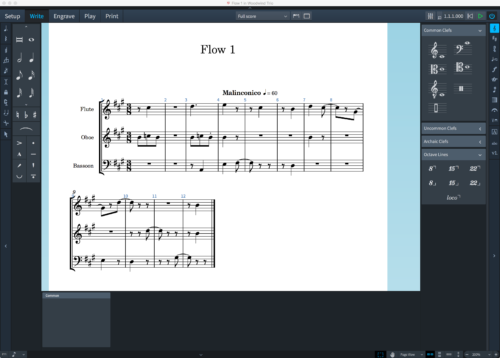
The intelligent capture and manipulation of music in notation in such a way that your music can be performed from the resulting (printed) score by musicians is both a highly specialized enterprise, and a demanding one. Competent musicians had better be involved in the conception, design, coding, documenting and even the presentation and marketing of such software at every step. As reported by Spreadbury in his blog, Making Notes, they were. And it shows: Dorico is a very strong product specifically because of that involvement by music specialists in determining and formulating the architecture, interface and user experience.
Although it was criticized by some as having been released prematurely, Spreadbury and Steinberg consistently and transparently explained in detail what was to be expected from Dorico’s first release, what was intentionally omitted, how that iteration would be built upon, and what would come over time, how and why.

Independence of form and content
Dorico is neither a sequencer nor a Digital Audio Workstation (DAW), although it has some features of each – such as a mixer and “piano roll†style (horizontal tracks) presentation of notes. What’s more, Dorico ships with over 30 effects processors, including convolution reverb, four-band channel strip EQ, limiter, compressor, and amp simulator.
Rather, Dorico’s job is to capture and manage music as score, not synthesized or sequenced sounds. Notes are input on individual five-line musical staves set out vertically down the software’s window.
The software is optimized for today’s multi-core 64-bit CPUs: experience during testing for this review confirmed a speed and streamlining (concentration of all your resources in a single window, for instance) which supports a variety of workflows. Dorico also does extremely well in supporting the creation and management of scores which comprise multiple movements such as song cycles and musicals. Modern compositional techniques such as complex and nested tuplets, microtonality and transparent notation of extended technique are supported.
At the same time, its interface is uncluttered and clean.
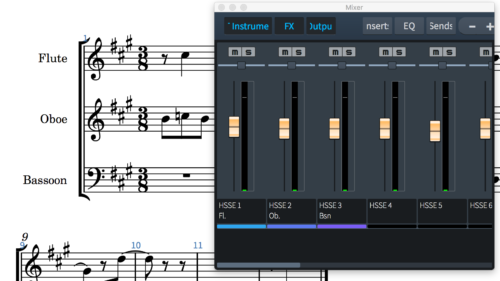
Creativity First
The balance between originating and manipulating discrete sounds on a computer and adhering to the many hundreds of accepted musicological conventions with which they are notated for publication is a fine one. For example most graphical scoring software expects that the first decision which a composer makes will be to define staves, how many and of which type(s).
This is determined by considerations about the disposition of instrumental and vocal resources. Whether and how doubled flutes – say – share a staff; or how many horns and clarinets there should be – and in which register(s).
Notes themselves are typically worked on only after all of this has been set up. This can lead to errors as composers try to shoehorn their creative conception into preset and (potentially) inflexible layouts. It can stifle creativity.
Dorico is different in that its goal is to shift this balance – if not actually reverse it. It works with and promotes the ways in which the music is actually conceived, developed and eventually made available for performance. Not to oblige composers to adapt their thought to an engineer’s GUI.
If Dorico were a word processor, it would allow you control over the layout (from bullets to chapters) of a document dynamically. It would let you change that document at least during – and at best after – your creative processes (some of them unconscious) take off as you initiate, structure, change and extend text in your head. The opposite of the linear letter-by-letter, sentence-by-sentence, model. Without ever having to cut and paste.
Steinberg states explicitly: “Dorico is designed to conform more closely to how music is performed in the real world and to make the score a flexible expression of the practical choices that go into a musical performance, rather than to make the musical performance subservient to the way the score was initially preparedâ€.
Four months of use confirm that this really is for the most part what Dorico does.
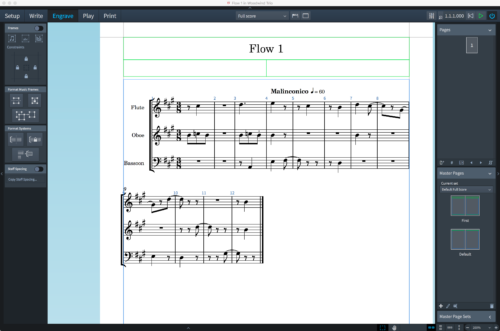
At the same time, significantly, Dorico does not compromise purely musical integrity. Conventions are respected. The resulting scores conform to performing practice. Steinberg has not gone its own way or departed from accepted styles and norms of and for performance in the slightest.
Scoring and instrumentation are complex processes – both horizontally (sequences in time) and vertically (rhythmic consistence and coherence). So for the Steinberg team to have struck the balance which they have in Dorico between harnessing and promoting the free flow of musical ideas while working in an environment necessarily built around icons, menus and an essentially 2D static metaphor is a huge achievement.
In Use
Dorico has its own Download Assistant; all aspects of installation worked without hitch for the first – and subsequent – versions of the product. On launch, Dorico presents the user with the Steinberg ’hub’. This will remind Sibelius users of its “Quick Start†window. The hub sets Dorico in context with tabs that take you directly to the user forum (see below), the download page(s) of the relevant part of the Steinberg website and the knowledge base, as well as a news feed on the left and the types of project available – a new or previously-saved one of your own and/or one of the three dozen or so predefined templates that come with Dorico.
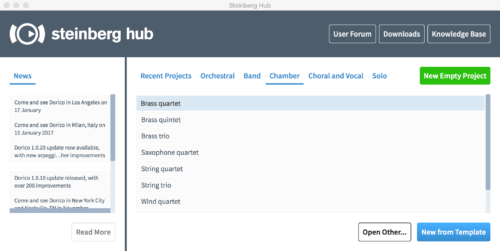
In the last three cases you will work in one at a time (although see below for the advantage of split windows) of the five distinct modes, whose names clearly indicate their functions:
- Setup
- Write
- Engrave
- Play
’Setup’ is performed before composition begins; you set the score’s components, its physical layouts – and participants. To notice the distinction between ‘players’ and ‘instruments’ is to notice a central example of the way in which Dorico departs from other scoring programs.
It respects how composition actually takes place… flexibility again. In reality, players can and do play more than one instrument… the flutist often doubles piccolo, for example. So a ‘player’ in Dorico could also be a singer, a choir, a member of a section where every member plays the same instrument; or a soloist.
You are setting up resources… say the winds or contraltos in a choir. Not software entities or objects. At the same time, you can also set ensembles and groups as well as (individual) instruments/performers. In the flexible world of Dorico it’s simple to create groups of instruments which you might want to re-use or transfer to another context independently of your current score or even “Flow†(see below). You can then exchange (copy, transfer) material between them without having to re-score it if needed. It doesn’t take long to see the advantages of this approach.
At its simplest: write the music and only later assign it to one (or more) player(s). And all in the same environment of Dorico. Such tools as you need to build that aspect of the score are always at your immediate disposal regardless of context.
In some ways you can almost consider the players, the way they play, and which instruments are assigned to them as the overarching concept of Dorico, rather than a series of Systems on the page of (and so virtually cemented into) a score.

’Setup’ is also where you determine and control ’Flows’. A Flow is an individual section of music within a project: movements or songs, for instance. Each project will contain at least one Flow. By default, every layout includes the music from every Flow in that project. This is a departure from the more common score-based approach of software like Sibelius. It’s designed – again – to foster creativity through flexibility. Once you’re used to the model, the chances are good that you’ll find that it does genuinely sponsor invention because you set aside the mechanics of System, “page†and screen management in favor of musical ideas.
Significantly, several score layouts can share musical content. In other words Dorico respects – more, it exploits to musicians’ advantage – the independence of music and the way in which the computer user commits it to a file (and ultimately to paper). For example “Insert Mode†automatically slides all other notes left or right when you add or delete notes from a voice, or change notes’ durations. There is nothing to be rewritten or “corrected†manually. Features like this will prove to be one of Dorico’s strongest selling points as the product develops and becomes more widely known, understood and taken up.
Writing and Playing
You write the actual music in Write mode; you play it in Play mode; and adjust literally every object in the project in Engrave mode prior to printing or exporting. You can determine how the pages of your project are formatted for later print or export. The latter process includes graphics and the inclusion of annotations etc for performance. Dorico is remarkably flexible and intelligent in the degree of control you have in terms of adjusting the appearance of your (finished) score.
A sense of the way in which Dorico works and the concepts behind it in terms of the art of composition can be found here.
By and large the functions for any one of these activities are only available in the relevant mode. This means that you have quick access to only those operations or settings which you need at any one point in the composition process. Clutter is entirely absent with no sacrifice of depth. Clean, unambiguous icons and a simple toolbar (which appears at the top in all five Modes) make navigation throughout Dorico straightforward and quick. You soon become familiar with Dorico’s conventions. Tools, text, feedback icons and all options are thoughtfully distributed across the ample space in which you work.
== writing graphic ==
In addition to the central work area, collapsible panels at the left, right and foot of the window give access to most major commands. They are grouped intelligently and ergonomically. Much thought has gone into making this interface as dynamic and interactive as possible. Context-sensitive menus abound.
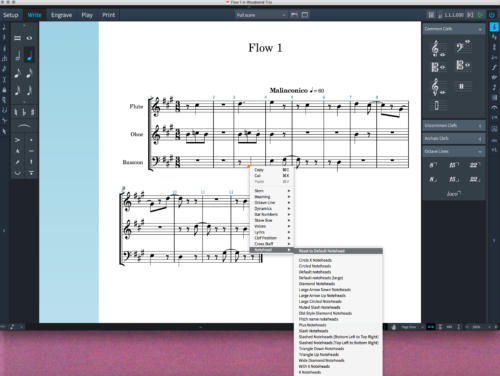
Equally impressive is Dorico’s ability to manage multiple windows on the same project. It’s simple, for instance, either to write and play in the same window; or to open two separate windows – one to write and the other to play – on the same Flow.
Then to switch between tabs for, say, the conductor’s score and individual instruments’ parts as well as split the window (horizontally or vertically) giving access to both simultaneously.
Unlike the more linear process of working with text, musical composition is an iterative – usually an intensely iterative – process: write – listen – edit – listen again – edit again – listen again – edit again etc. So it’s essential to be able to move as quickly and effortlessly as possible within and across your entire work environment (score, settings, playback, and eventually layout and engraving). Dorico really shines here.
Flows
You’re likely to spend most of your time composing (or arranging, engraving, publishing, copying – even teaching or studying) an individual Flow. In Write Mode notes can be input and managed (edited, moved, deleted) in almost every conceivable way including directly from the computer keyboard – another example of Dorico’s standing behind the user rather than blocking them:
- a “rhythmic grid ruler†shows the distance by which the caret moves (with the arrow keys) from one note or test to the next or previous one
- the Q shortcut allows chords to be built quickly, root up
- another shortcut (/) is for grace note input
- you can easily copy music between instruments and change pitches without necessarily having to change rhythms
- analogously, Dorico’s default notation of rhythms can be overridden
- ties can be removed with a scissors tool and so cut or split existing notes
- there is sophisticated management of rests
- instruments can have unlimited voices (layers)
- collisions between items on the score are automatically avoided as with Sibelius’ Magnetic Layout
- the caret can be moved between staves with the arrow keys
- notes’ pitches, durations, accidentals, and articulations can be input using the QWERTY keyboard
- both MIDI and mouse input are supported; but a Selection tool allows you to disable mouse input if you want to use computer keyboard for input and the mouse specifically for making selections.
Some of these are amongst the several dozen new features or implementations unique to Dorico. As are the following:
- choice of the duration of accidentals (common practice, Second Viennese School, “Modernist†etc.)
- control over temperament such that you can set arbitrary numbers of Equal Divisions of the Octave (EDOs); this can include accidentals from triple flat to triple sharp in 12-EDO, and quarter-tone accidentals in 24-EDO
- many aspects of appearance… extremely precise and flexible spacing, bracketing, beaming, slurs, positioning, and a pleasingly large number of innovations with text markings – the way in which Dorico handles dynamics, for example.
All of these aid smooth and swift composition for the expert wanting almost infinitely precise control over even the most minute aspect of their styling as much as for those who want to be confident that Dorico’s defaults will serve their needs. Other keyboard shortcuts (such as 1 to 9 for note duration; “0â€, “-“ and “=“ for accidentals; and T for ties etc) are logical and quickly memorized.
The Project Window contains the Notes Toolbox, Notes Panel, Properties Panel, Notations Panel and Notations Toolbox. The positioning of tools has been thought out well: each is easy to find, clearly represented graphically/iconically and intelligently placed according to where/when it is likely to be used.

Mac users who favor the soft and subtle 3D font and window style of our OS and its most visually pleasing and sophisticated software may find the simpler, starker design style of Dorico a little cold or soulless. But you get used to it – not least because it reflects the clean design, and stability of the package. Nor do you have to wrestle Dorico. It does work with you once you’ve become familiar with its metaphors and basic design concepts.
Yes, there are quirks. And No, perhaps the Steinberg HALion Symphonic Orchestra library (which is included complete with Dorico) and 1,300+ sounds from HALion Sonic SE 2 – even with its over 100 patches and combinations – isn’t the most impressive of VIs (virtual instruments). Yet it’s on a par with Sibelius Sounds, the basic VIs which come bundled with that product.
Full integration with third party products such as those from the Vienna Symphonic Library is either implemented now (all VST 3-compatible virtual instruments and effects now work with Dorico), or planned. On the other hand Dorico comes with the same audio engine that’s used in Cubase and Nuendo.
In the very first release (which was updated within a month) it wasn’t possible to hear your notes as you input them in Write mode. This was quickly corrected. There are still some similar features which aren’t yet available – such as having pitches appear on screen as you input notes in Write mode… you might have to stop and think about a note two or three ledger lines above or below the viola’s C clef – in which, perhaps, you work less frequently.
Updates
It would be naïve to overlook the criticisms which Dorico attracted on its launch last year. But just as wrong to misunderstand or underestimate what Steinberg has achieved and is likely to achieve with Dorico. It represents the most significant event in the history and world of such software in many years. Indeed, Dorico is also likely to influence positively the way in which other such software develops; and the integration of adjunct resources like Virtual Instruments, the MIDI interface, the engraving process itself.

Following the initial release (version 1.0.0) in October, the team at Steinberg obviously identified the major shortcomings of the product very quickly. Indeed, the update page on the Steinberg website is unapologetic that… “Dorico has many unique and innovative features not found in any other software, and presents a whole new way of working with music notation, but because it is brand new, it does not yet have every feature necessary for every kind of score. Dorico will receive a number of updates in the coming months that will be free to existing users, adding new functionality.â€
And this is exactly what is happening: at the end of November 2016 version 1.0.10 introduced significant speed and performance improvements. There was a new Transpose dialog, editable vertical staff/system spacing in Engrave mode, better handling of transposing instruments and those which do not show key signatures; elementary VST Expression Maps were introduced; and improved ways to select passages became available. Many bugs were squashed.
Less than a month later, version 1.0.20 continued the trend with greater and better control over playback, articulations, slurs, dynamics, tremolos, arpeggiated chords and grace notes. Bar rests in additional voices and across staffs were improved. More bugs were squashed.
Faith in the Team
What’s more, users really can, have and do make a difference: contacting the development team doesn’t guarantee a fix or the inclusion of a feature, of course. But experience suggests that such communications are listened to. Steinberg has already announced that forthcoming releases will enhance or include the use of chord symbols, repeat ending lines, fingerings, jazz articulations, rhythm slashes, more flexible notation of unpitched percussion and – a little more amorphous but welcome – steady improvements to playback.
It would be a mistake to expect Dorico – even with the resources of Steinberg at its disposal – to be capable of, say, as much as Sibelius is after 30 years (development of that product on the Acorn RiscOS platform began in 1986). For example, Dorico inevitably lacks the wealth of third-party plugins of the former. Experienced users of such software have not been slow to point out the lacunae. But shortcomings are just that: gaps waiting to be filled, not fundamental faults, flaws or misunderstandings of either the market/user community or of the process of composition. Few users have been able to advance convincing reasons not to stick with an exciting and extremely promising enterprise that has all the signs of great success.

Users and (potential) buyers will get a good sense of how, where and how fast Dorico is developing, being used and benefiting from input from other users by visiting the lively Dorico forum. Indeed, the team at Steinberg appears to have no illusions about the quantity and quality of development which will be needed to make Dorico as fully-featured as, say, Sibelius is after all this time. This counts for a lot and should influence your decision as to whether or not you want to become part of this exciting project.
If you do, you’ll be owning a revolutionary product. It already does much, or even most, of what many composers need. In as little as three or four months criticism dwindled or proved largely unfounded. Most encouragingly, those many users who actually settled down to work with Dorico began to discover that their faith in Spreadbury, the ex-Sibelius team, and Steinberg’s momentum and understanding of the market was far from misplaced.
Parity
If you are a Sibelius or Finale user, you won’t find the richness and scope of those programs in Dorico version 1. But there are many other aspects of this new software which offer compensations – depending on your requirements. You’d be advised to evaluate the product (which can be done for 30 days free) before deciding whether you can use it to complete mission-critical projects.
It takes even the most experienced and talented teams a very long of time to identify, design, develop and test such complex and sophisticated software as that handling note input. Even longer when you take into consideration the necessary involvement of musicians’ insights into an essentially new way of scoring. That Steinberg has built Dorico as well as it has is remarkable. Even if you discount the future promise which this represents, try Dorico as it works now. The quality and quantity of what it can do represent an achievement to be applauded and make Dorico a product to be recommended.
Conclusion: Dorico is clearly the way in which complex and sophisticated music notation software is likely to develop. Its solid foundations are built on a deep and exhaustive understanding by the Steinberg team of how musicians really want to notate their compositions and arrangements.
Given the pedigree, experience and market penetration of Steinberg in the field, it seems highly likely that future versions of Dorico will soon catch up with its rival products. Indeed, there are already many aspects of scoring which only Dorico can do – and do well. As for those which it cannot, if Dorico version 1 is any indication of what Steinberg can produce without using any old or legacy code in such a short time, its future looks very bright. It is a product to be safely recommended.
Pros: Ease of use; flexibility; Dorico has been successfully designed to work as composers and arrangers actually think and work; great potential for extension and the addition of features, third-party enhancements such as more Virtual Instruments; complex and deep set of functions extremely easy to navigate and remember; fast; clean and approachable interface; good support; takes advantage of other Steinberg audio products; import of files in other common formats such as MusicXML (so potential integration with competitor products such as Sibelius, Finale and Notion) with a cross-grade offer for users of these.
Cons: Some would say that Steinberg didn’t communicate adequately that Dorico’s first version was to be considered a work in progress, and that its users were also buying into the development of a still evolving yet reliable process; early documentation and some arguably-crucial functionality missing.
System requirements: Mac OS X 10.11 El Capitan/macOS 10.12 Sierra with the eLicenser license management Control Center and at least 4 GB RAM (8 GB recommended) with 12 GB free storage space.
MyMac.com Rating: 9 out of 10

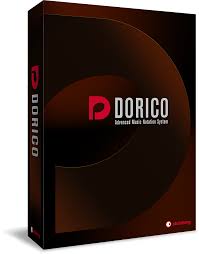
Leave a Reply
You must be logged in to post a comment.